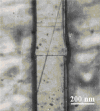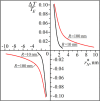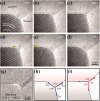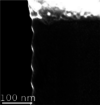About the Shape of the Crystallization Front of the Semiconductor Nanowires
- PMID: 36910933
- PMCID: PMC9996779
- DOI: 10.1021/acsomega.2c06475
About the Shape of the Crystallization Front of the Semiconductor Nanowires
Abstract
During the nanowire (NW) formation, the growth steps reaching the crystallization front (CF) under the catalytic drop are either absorbed by the three-phase line or accumulated in front of it, curving the surface of the front. In this paper, we have analyzed the conditions leading to a change of shape of the crystallization front of the NWs under the catalyst drop as well as the reasons for the formation of atomically smooth (singular) and curved (nonsingular) regions. A model explaining the curvature of the crystallization front under the drop in the process of NW growth is proposed. The model demonstrates that under conditions of good wettability of the crystalline surface with a catalytic liquid and nucleation at regular places of the growing NW face, a metastable equilibrium at the CF near the three-phase line is achieved due to the thermodynamic size effect of reduction of overcooling (supersaturation). This metastable equilibrium results in the curvature of the CF. The CF curvature depends on the NW radius and the level of overcooling (supersaturation) in the droplet. During this process, the low-index inclined facets adjacent to the wetting perimeter of the catalyst drop may appear on the curved CF.
© 2023 The Authors. Published by American Chemical Society.
Conflict of interest statement
The authors declare no competing financial interest.
Figures















References
-
- Thelander C.; Agarwal P.; Brongersma S.; Eymery J.; Feiner L.; Forchel A.; Scheffler M.; Riess W.; Ohlsson B.; Gösele U.; Samuelson L. Nanowire Base One-Dimensional Electronics. Mater. Today 2006, 9, 28–35. 10.1016/S1369-7021(06)71651-0. - DOI
-
- Ishikawa F.; Buyanova I. A.. Novel Compound Semiconductor Nanowires: Materials, Devices and Applications; Pan Stanford Publishing: Singapore, 2018.
-
- Natarajan C. M.; Tanner M. G.; Hadfield R. H. Superconductor Science And Technology Superconducting Nanowire Single-photon Detectors: Physics And Applications Superconducting Nanowire Single-photon Detectors: Physics and Applications. Supercond. Sci. Technol. 2012, 25, 06300110.1088/0953-2048/25/6/063001. - DOI
-
- Fang X.; Bando Y.; Gautam U. K.; Ye C.; Golberg D. Inorganic Semiconductor Nanostructures And Their Field-emission Applications. J. Mater. Chem. 2008, 18, 509–522. 10.1039/B712874F. - DOI
LinkOut - more resources
Full Text Sources

